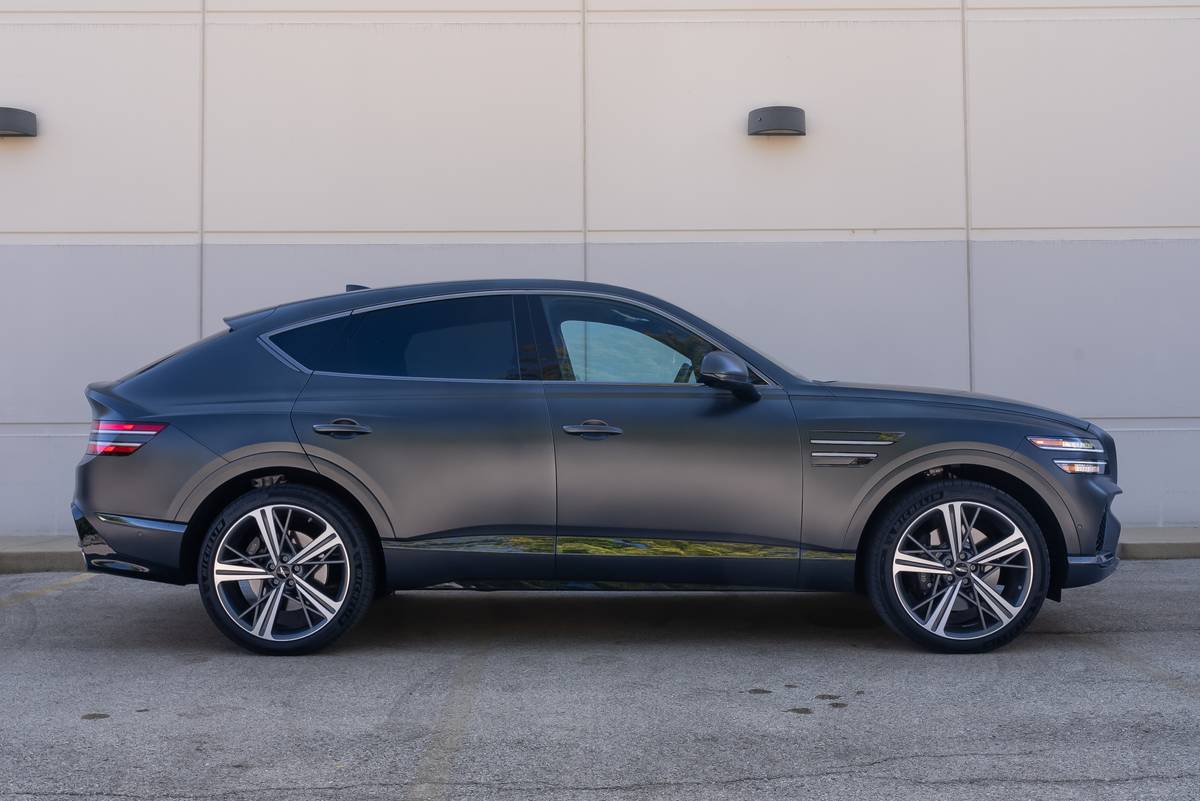Cincinnati.com's view
Call it the thinking man’s – woman’s alternative. The Volvo V70 Cross Country station wagon does more than most folks ever ask of their sport-utilities, and does it in comfort and style. I snickered a bit when it first arrived – the butched-up front end seemed a little out of place on what is typically one of the more dignified-looking car lines.
Behind-the-wheel experience and a closer scrutiny of the sheetmetal disabused me of that erroneous first-blush impression. Similarly, my first driving impression was other than favorable, but was later amended. On my short first-day familiarization run, I was surprised to find the Cross Country wagon handled sluggishly and unresponsively, and sort of waddled over an undulant stretch of asphalt. It was not at all the crisp handler I remembered the 70 Series machines to be.
I soon found out why – the tires were a uniform six pounds below the manufacturer’s recommended inflation pressure. (Checking the manual, I was amused to see that the “tyre” pressure recommendations were metric – kilopascals. Happily for a provincial like me, there was a sticker on the fuel filler door which provided the more familiar pounds-per-square-inch frame of reference. Don’t the Swedes know we and Myanmar cling to the old ways?)
A quick trip to the corner gas station for a fuel top-off and four jolts of air produced an amazing transformation. The V70 Cross Country (XC in Volvo’s nomenclature) became as lithe and supple as its more citified brethren, with the added advantage that all-wheel drive confers.
The Volvo uses a full-time system. In steady-state cruising, it sends 95 percent of the available power to the front wheels. A viscous center differential can vary the front:rear distribution through an infinite range, even to the point that the rear axle does all the work, when it alone has traction. As is typical of such systems (used also on VWs and Audis, as well as Subarus), there is neither a low range nor a mechanical lockup between front and rear axles, but these features are necessary only for the most extreme conditions.
Instead, the XC has a left-right traction control system, which can apply braking pressure to the side whose wheels are slipping so that the opposite wheels get the go power. It’s not the most elegant way of going about it, but it’s fairly simple, and works quite well. On good-traction surfaces, the XC handles much like any front-drive car, although the careful observer will note that under heavy throttle application, there’s less front tire spin than one might expect. In daring cornering maneuvers, one can stay on the throttle more than would be possible with a 2WD machine.
Getting up to speed rapidly (0-60 in 7.7 seconds, I measured) is less dramatic than it would be on a car which only drives two of its wheels. This can fool you into thinking the car is slower than it is. Similarly, on the highway, the smoothness of the ride and the excellen t sound insulation mean you had better keep an eye on the speedometer – I found my seat-of-the-pants estimation of speed was dangerously low.
Shock isolation was excellent – even fairly large pavement breaks were merely shrugged off.
The XC is just a bit over five feet tall, so entering is easy. And when you do, you’ll think you’ve plopped down in a tack room if you’ve popped for the optional leather bits. The aroma is powerful and delicious. The leather stitching and other interior details are simply exquisite, quite in keeping with the luxury-class pricing. Instrumentation was well placed and easy to read.
The optional navigation system uses Global Positioning Satellites in conjunction with updateable CD-ROMs not just to show you where you are and where you’re going, but to show points of interest along the way, such as automated tellers, gas stations and restaurants. In my home area, I was surprised at how detailed the listings were. Volvo’s nav displa like any other I’ve seen, rises from the top of the dash when it’s activated. This makes sense; these things can be more distracting than cell phones, so having it near the normal field of vision allows a more rapid scan. I can see the reasoning behind the similarly idiosyncratic practice of locating the nav controls on the steering wheel, but the implementation leaves much to be desired. The switches are small and out of sight on the back of a spoke. Better, I think, to mount them next to the LCD panel.
The XC gets its hustle from a five-cylinder, 2.4-liter alloy engine with twin camshafts, 20 variably-timed valves and a light-pressure turbocharger. The mighty mite dispenses 197 hp at 6,000 rpm, and 210 foot-pounds of torque between 1,800 and 5,000 rpm. The adaptive valve timing gets credit for the flatness of the curve. In actual use, it feels more like a larger-displacement engine than the typically peaky turbo, willing at 1,500 or so and eager beyond 4,000. The turbo also serves to mute the generally unpleasant sound of the uneven firing pulses of a five-banger.
measured 18.2 mpg on the recommended premium unleaded and that included some crawling around muddy construction sites to assess the tractive abilities. EPA estimates are 17 mpg city, 22 highway with the one-and-only five-speed automatic transmission.
The gear-changer worked splendidly, although I found the manual mode somewhat obtuse and largely superfluous. They’ve used the five ratios to good advantage – first is quite low and top is a relaxed overdrive.
The XC has excellent brakes, discs front and rear. Stopping was very powerful and well-controlled, complemented by the large contact patch provided by the H-rated 215 – 65 – 16 Pirelli Scorpion “tyres”.
In keeping with its promise to help you find your own camp site, the XC has 7.6 inches of ground clearance with two aboard, comparable to many sport-utes, without their high center of gravity.
The rear seat would be quite comfortable for two adults. It is split 40:20:40 to allow skis or 2x4s to be carried. The cargo area per se is twice as big as a big car’s trunk (37.5 cubic feet), and with the rear seats stowed, swells to 71.5 c.f. A third seat is available for munchkins.
Volvo’s big pitch has always been safety, and the XC should fill the bill. The Insurance Institute for Highway Safety smashed the sedan version and gave it top marks – five stars – for passenger and co-pilot survivability. This is achieved through not only controlled-deformation chassis and body engineering but also front and side air bags and inflatable head curtains, along with sophisticated seat belt mechanisms.
Consumers Union says reliability of the 70-series has recently taken a turn for the worse and they no longer recommend it, though they paradoxically do predict well-above-average customer satisfaction. With the 2001 revisions, I think their assessment is out of date, and w ould not hesitate to recommend this gratifying machine.
Base price on the Cross Country is $34,900. It wasn’t hard for Press Relations to blow that up to $43,480, including freight, with a romp through the appealing options list. Metallic paint is $400; leather-faced seating surfaces, $1,300; leather steering wheel, $200; trip computer, $250; navigation system, $2,500; audio upgrade, $1,000; first aid kit, $30; auto-dimming mirror, $100; security laminated side windows, $300; leather shift knob, $65; Homelink, $125; crossbars for roof rails, $135; cold weather package (heated front seats and headlamp washers – wipers), $450 and versatility package (third seat, cargo security cover, cargo net), $1,150.
“The Gannett News Service”
Latest news


10 Biggest News Stories of the Week: Jeep Wrangler Rides on Audi E-Tron GT, Chrysler Pacifica Hybrid

